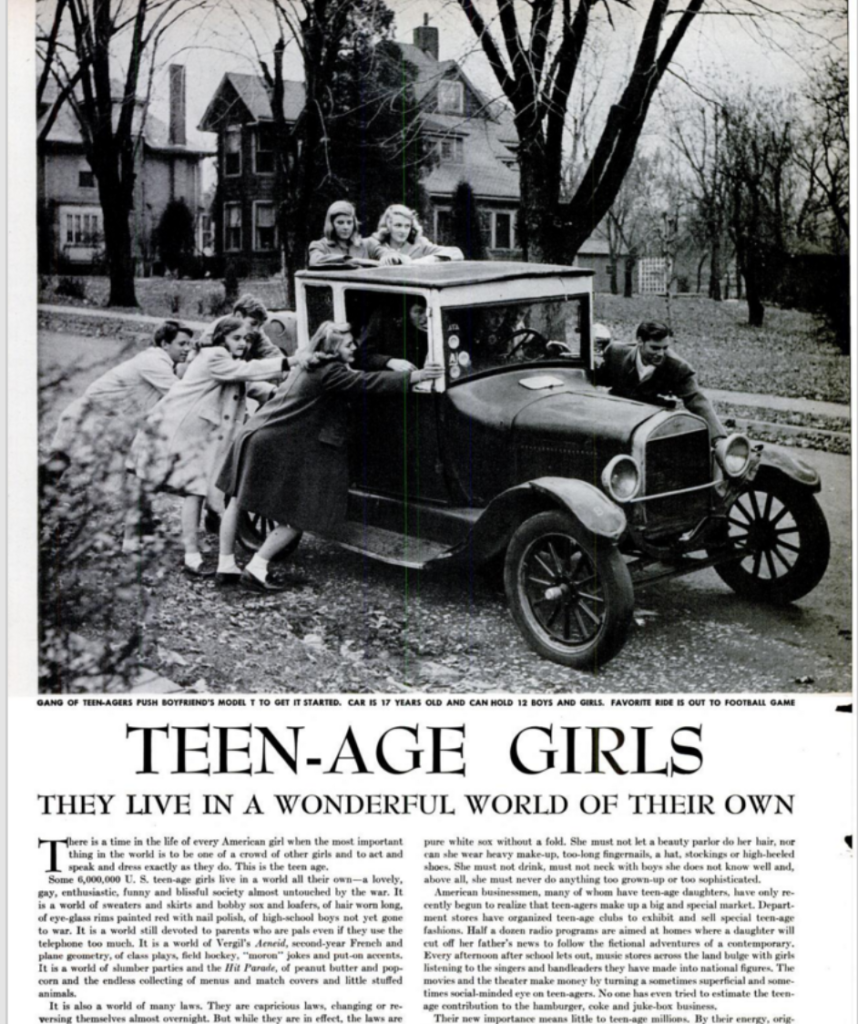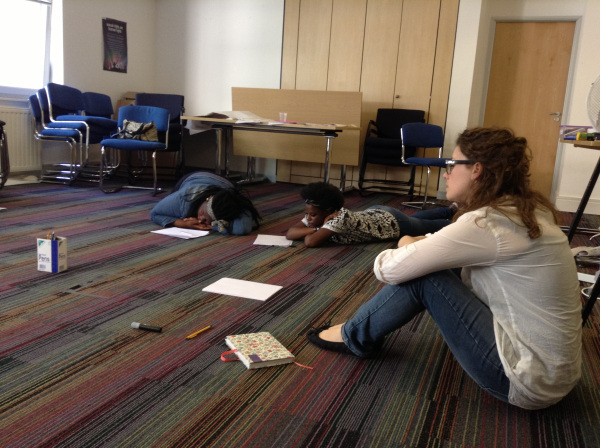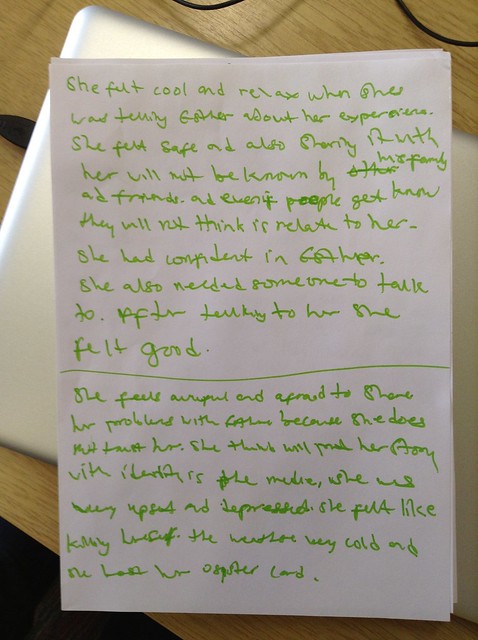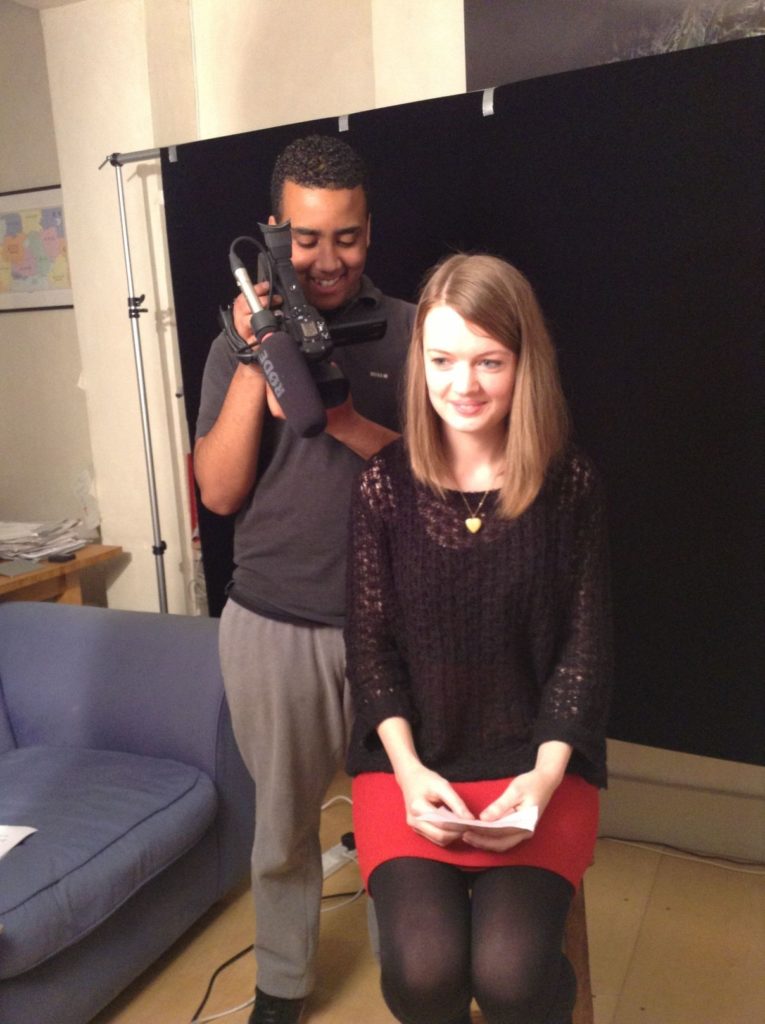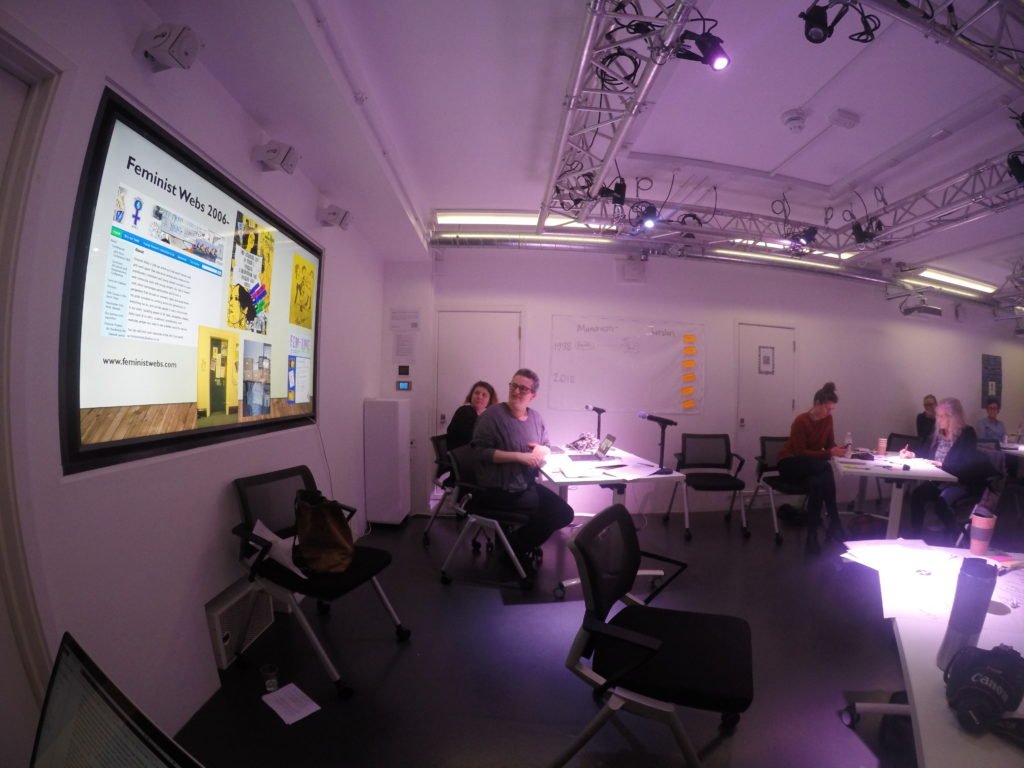By Lucy Robinson
In this blog I am going to introduce the Mass Observation Project and its digitised off shoot – Observing the 80s.

The Mass Observation Project (MOP) is a volunteer writing project based at the University of Sussex. There are currently 450 writers (often referred to as ‘observers’) who respond to ‘directives’ or open ended questionnaires that are sent to them three times a year by email or post. The Directives contain two or three broad themes that writers are asked to comment on ranging from personal issues to wider social and political themes and events.
Each observer is issued with a code which is used to give them anonymity and allows them to write candidly if they wish. As a result, the Project solicits in-depth accounts of everyday life: stories, memoirs, lists, letters, diagrams, drawings, maps, diaries, photographs, press cuttings, confessions, reports on people, places and events, across a wide variety of topics. Since it was launched in 1981 over 4,500 people have volunteered to write for the project.

Observing the 80s is a relatively small scale project, which brought together oral history, mass observation
responses and ephemera from the 1980s. The material, which has been made available as an open educational resource, offers a unique insight into the lives and opinions of British people from all social classes and regions during the 1980s.
The value of digitising these collections is that there was previously no established historiography of the 1980s. The decade was largely represented as polarised and the work that did exist was similarly divided into oppositional camps. By bringing together these resources from the MOP and the British Library Oral History Collections, students and academics are able to make and illustrate connections across and between these polarised approaches.
Observing the 80s was ostensibly a teaching led project, but it has taught me a lot about how I want to research, and how I might think about the journey between a piece of evidence’s initial context of production and its ongoing accrual of historical meaning, through use, and subsequent reuse. When we reuse data, each time it is picked up and picked through we add a new layer of our own meaning. The Mass Observation Project (MOP) writers have taught me to think about that historical acquisition of meaning, from production to reception, and to listen to the producers of our evidence as analysts or collaborators.
Mass Observation perforates the line between who is the researcher and who is being researched. It builds collaborations between the original researchers asking their questions in the past, between the respondents who shared their analysis, and between researchers since.
To illustrate this I’m going to use two MOP directives from 1988 to draw out the complicated ways in which events and linear narratives are intertwined, and how the barriers between evidence and analysis are perforated over time. I combine the directives and the responses to them, and the contextual explanation of the directives that Prof Dorothy Sheridan produced for the Observing the 80s project.
27. Autumn 1988: Part 1: Regular Pastimes SxMOA2/27/1
The first directive is form Autumn 1988. It was intended to capture TV-watching within a broader context and asked the correspondents about their leisure activities described as ‘Regular Pastimes’.
Regular Pastimes – that is to say not occasional (e.g only at weekends) or seasonal (e.g only in the summer). Reading is an obvious example but there are others things like listening to (and making) music, writing (letters, MOP observations etc), listening to the radio or watching TV, and crafts of all sorts of which knitting is only one example. What I would like would be a record of the place that such activities have in your daily life: when do you engage in them (e.g every spare moment, or set times); for how long usually; do you do something else as well; how do they fit in with the activities of other members of the household; if there are financial costs or limitations what are they, and, if there are end products, what happens to them?
The answers to this directive focus on newspapers, magazines, and all sorts of writerly and readerly pursuits as well as the physical space that readable objects, or their shelving, occupy in the home, The respondents interpreted the directive’s prompts in various different ways. Some produced a diary of what people did to pass the time, other provided a detailed account of their leisure activities. The respondents also interrogated the meanings of particular terms, for example the meaning of ‘regular’.
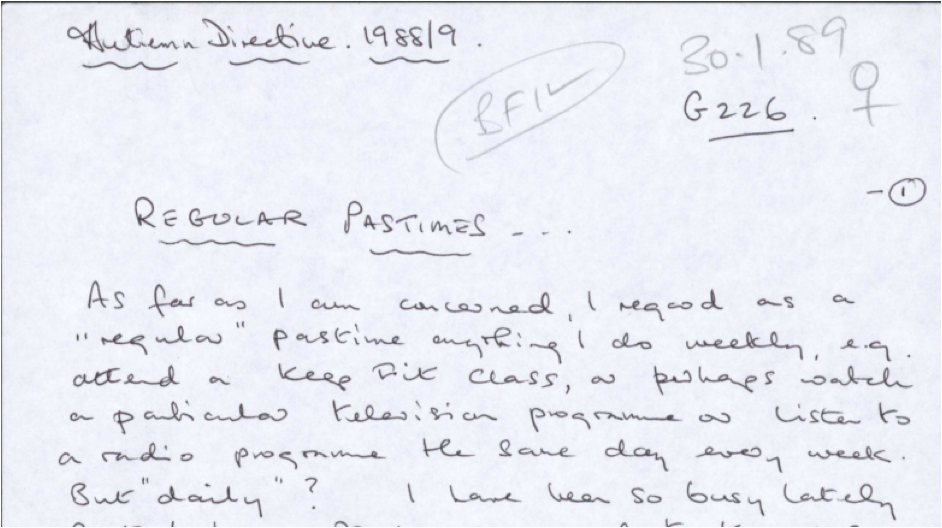
Some explore what reading means to them in vibrant ways. Reading romantic novels, or magazines like Valentine, mark life-cycle stages and book clubs provide social connections outside the family.
Not only does their voluntary participation in the project as a whole demonstrate the importance of the written word, their answers share the variety of ways in which writing matters and how it connects different parts of their lives. The etiquette around a quick response time to a letter, or regret for unfulfilled ambitions to become a writer as a younger woman, (C1191), another attended creative writing groups (G218).
The respondents also use the directive as an opportunity to think about what time means to them, and indeed the emotionality of time. Whether they are talking about how the day, or the week or year is structured by activity, the responses map periodisation as an experience. They also challenge some of the divisions between activity as leisure and work. As Langhamer has pointed out the categories of work and leisure are emotionally forged through gendered structures. A woman’s leisure activity (baking, sewing, playing with children) could equally be seen as work in a different context. Together these writers have taught me to be mindful of the ways in which people define these borders and perforations for themselves, rather than expecting them to fit into my boxes as a researcher.

B1106, M 1945
And to think about how time, and life cycle stage intersect.
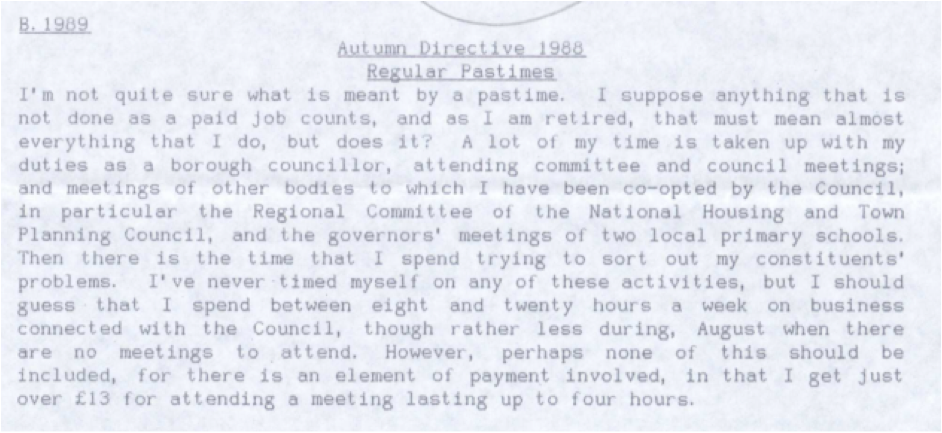
When writing about their pastimes respondents include where they shop, what they listen to on the radio, some also include MO as a pastime, occupying this space across and between unpaid work and leisure.
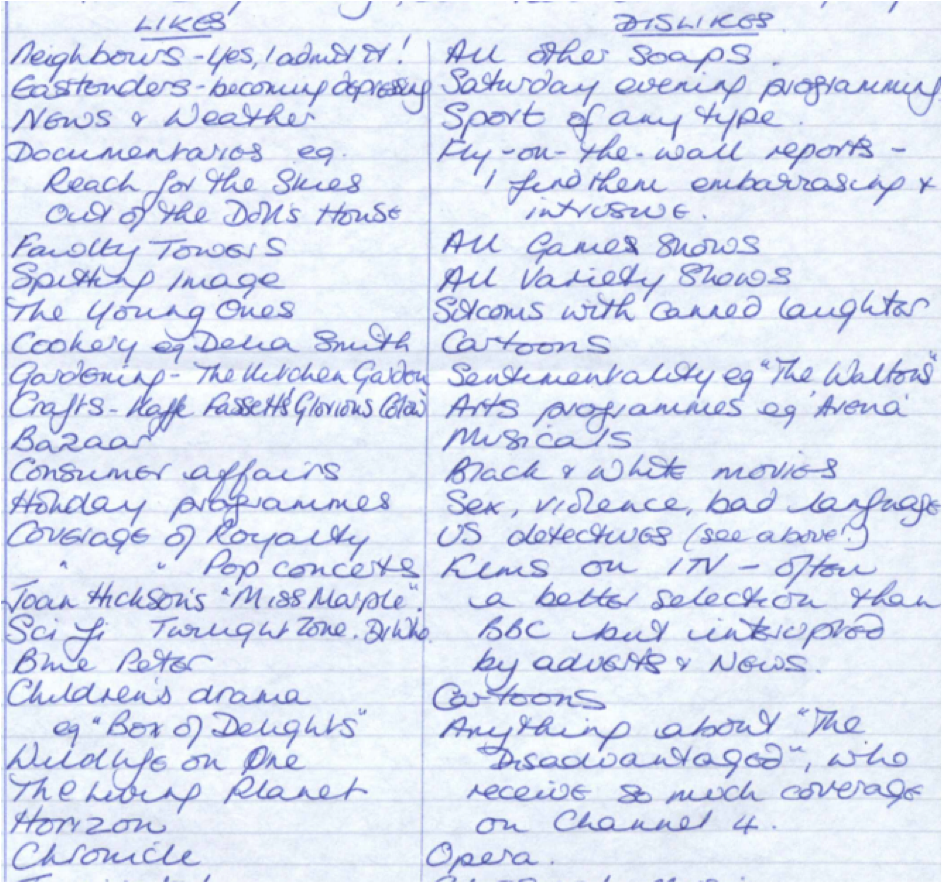
The List is a classic MOP frame. Respondents are often invited to make lists, and revisit them with others, to be the observer. But lists are also a way of taking control of content. Sometimes when the directives they are responding to are wordy, unclear or laboured, the respondent uses a list to gets down to what really matters to them; just the key objects or events.
27. Autumn 1988: Part 2: TV Day-Diaries SxMOA2/27/2
The British Film Institute (BFI) approached the MOA to participate in a national ‘Television Day Diary’ to capture on one day what people were watching on TV. The directive went out in the post with a colour printed form which explained the BFI’s intentions and offered space on the form for the day diary. The form was not restricted to the Mass Observers – it was the BBC’s general public form. Copies of the form were donated to the MOA.
Dear Observer, An unusual package this time. The British Film Institute has asked for our cooperation in their lst November “Television Day Diary” project – an idea inspired by MASS-OBSERVATION in the first place. The enclosed leaflet is self-explanatory but I’d like to emphasize two points: – The “Day Diaries” must be sent to the British Film Institute, 21 Stephen St, London W1P 1PL, and not to the Archive. – The BFI competition deadline is November 19th. This deadline does not apply to your response to the topics below which should be returned to the Archive as usual. I would be grateful for your help in this because your TV “Day Diaries” will finally be returned to us and will be a valuable addition to our collections. Please fill in the tear-off slip at the end of the Directive and return to us with your Directive reply. This will give us an idea of how many of our correspondents have taken part in the BFI project.
Setting the directive up as a letter (“Dear Observer”) breaks down the relationship between contributor and archivist reiterating that we are in this together in a shared endeavour, but more interestingly for this Directive the commissioning process is explicit in the form and content of the responses.
In terms of content the responses map different social values; some observers had embraced breakfast TV and it had the changed shape of their day; responses show the perennial concerns over violence in children’s cartoons appear regularly; respondents felt that there were too many quiz shows and too much Snooker coverage in the schedule and a number of respondents engaged with discussion of Pat Butcher’s earrings and how depressing Eastenders had become. There were those who identified themselves by their taste, whether they loved or hated Neighbours, or Terry Wogan. Responses also show people starting to use video recorders to fit TV into their life rather than the other way round. There were also numerous concerns about TV ‘ruling our lives’.
Even though this directive was explicitly for the BFI, and even though it looked different than the usual directives in form, MOP writers took their expectations of MOP with them in their answers. As researchers we also get some slightly different contextual information. BFI ask them to add their current marital status, and occupation. As Annabella Pollen has demonstrated looking for representivity is not the most interesting way to work with MOP. Because MOP is a writing project not a survey it is generally less interested in blunt markers of category around class for example. If I’m honest, this is what I love about working with MOP but it can be a bit frustrating when you just want to know a bit more basic background on the writers.
Respondents showed how perforated their own lives were.
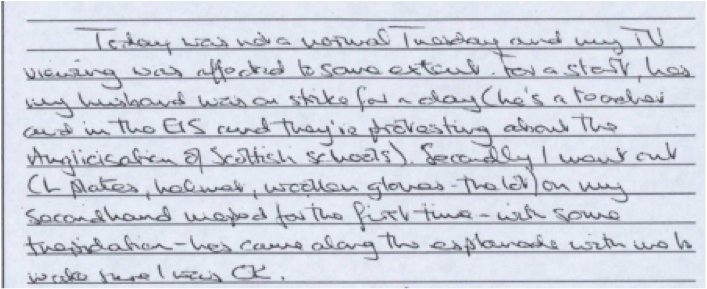
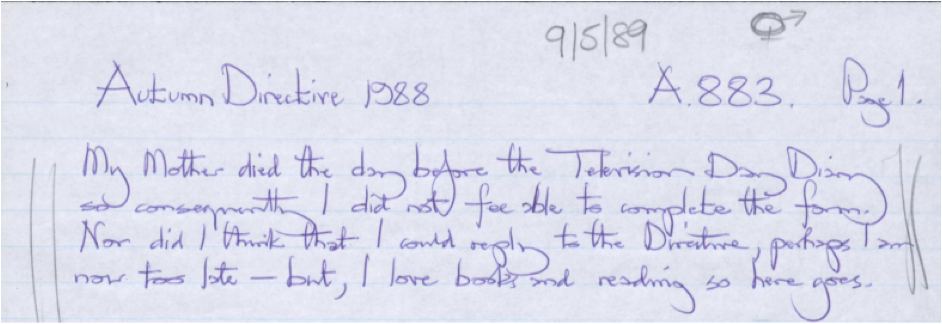
These are reflexive researchers.
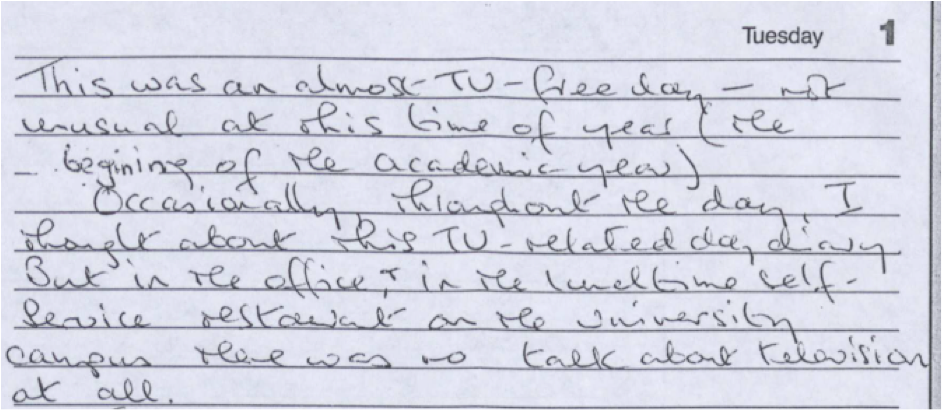
They record the process of their own research…
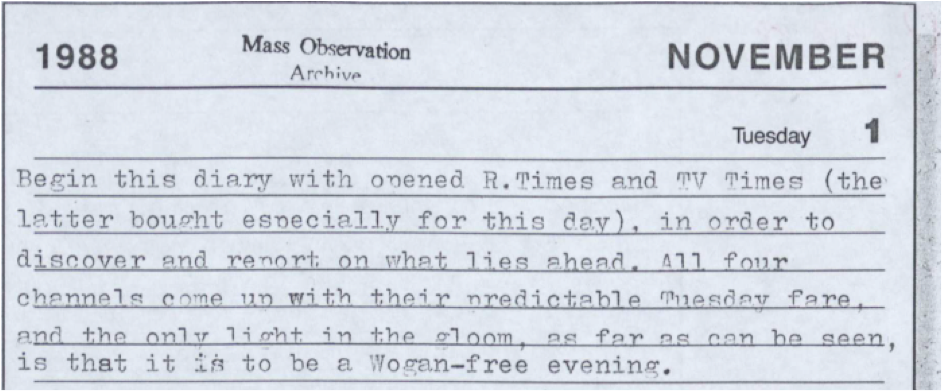
… and make their own analysis of what the research is for and why it matters.

As co analyst MOP writers feel entitled to take control of the agenda, this is ‘their’ project after all.
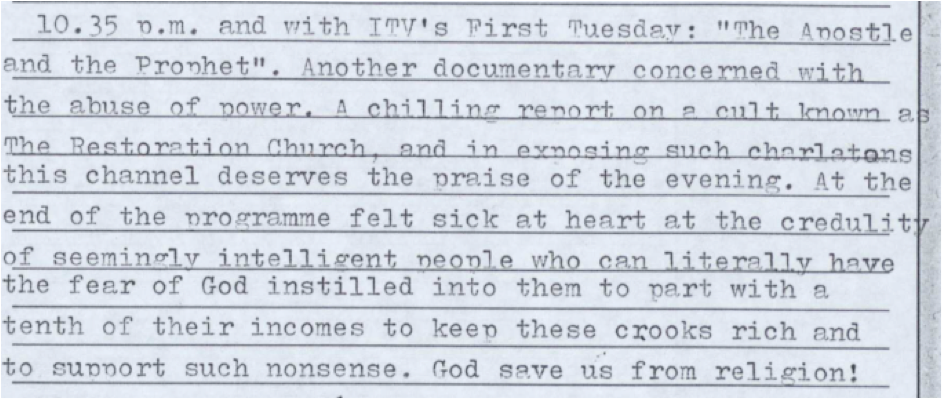
And they also feel licensed to critique the agenda and the process.
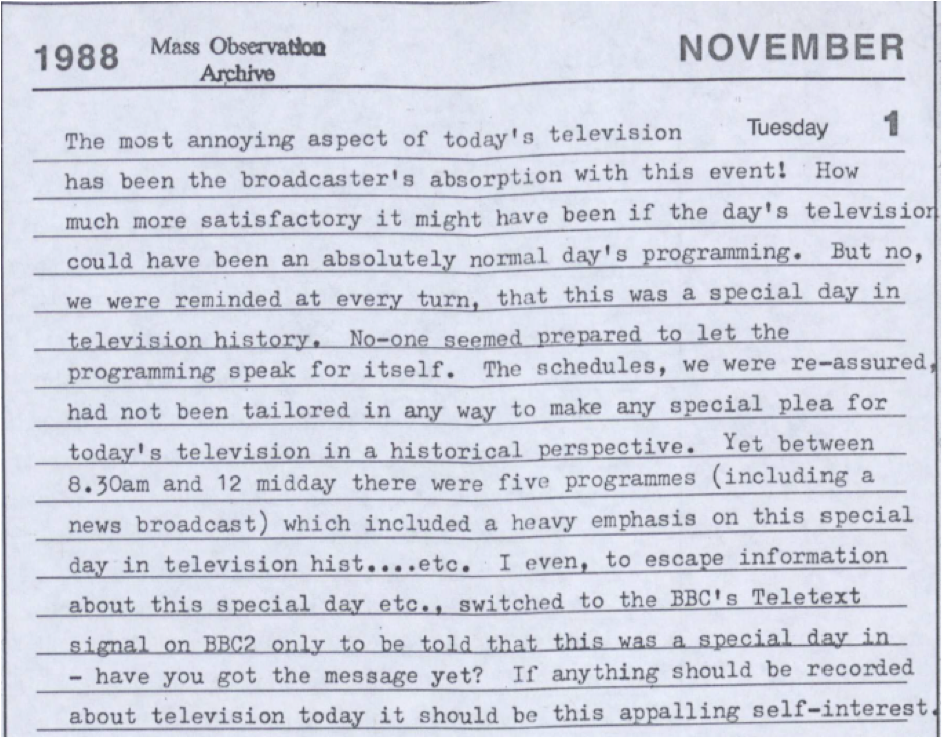
In this post I have worked through a few responses to a couple of Mass Observation Project directives. For me the scale or the breadth of the evidence is not the point, it is the journey that the evidence has made, from complex context to complex context, accruing meaning, resisting agendas, setting new ones, and inviting us to think in perforated rather than disconnected ways.

